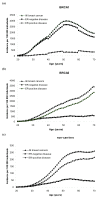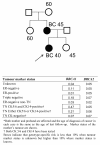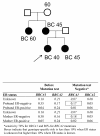Incorporating tumour pathology information into breast cancer risk prediction algorithms
- PMID: 20482762
- PMCID: PMC2917017
- DOI: 10.1186/bcr2576
Incorporating tumour pathology information into breast cancer risk prediction algorithms
Abstract
Introduction: Mutations in BRCA1 and BRCA2 confer high risks of breast cancer and ovarian cancer. The risk prediction algorithm BOADICEA (Breast and Ovarian Analysis of Disease Incidence and Carrier Estimation Algorithm) may be used to compute the probabilities of carrying mutations in BRCA1 and BRCA2 and help to target mutation screening. Tumours from BRCA1 and BRCA2 mutation carriers display distinctive pathological features that could be used to better discriminate between BRCA1 mutation carriers, BRCA2 mutation carriers and noncarriers. In particular, oestrogen receptor (ER)-negative status, triple-negative (TN) status, and expression of basal markers are predictive of BRCA1 mutation carrier status.
Methods: We extended BOADICEA by treating breast cancer subtypes as distinct disease end points. Age-specific expression of phenotypic markers in a series of tumours from 182 BRCA1 mutation carriers, 62 BRCA2 mutation carriers and 109 controls from the Breast Cancer Linkage Consortium, and over 300,000 tumours from the general population obtained from the Surveillance Epidemiology, and End Results database, were used to calculate age-specific and genotype-specific incidences of each disease end point. The probability that an individual carries a BRCA1 or BRCA2 mutation given their family history and tumour marker status of family members was computed in sample pedigrees.
Results: The cumulative risk of ER-negative breast cancer by age 70 for BRCA1 mutation carriers was estimated to be 55% and the risk of ER-positive disease was 18%. The corresponding risks for BRCA2 mutation carriers were 21% and 44% for ER-negative and ER-positive disease, respectively. The predicted BRCA1 carrier probabilities among ER-positive breast cancer cases were less than 1% at all ages. For women diagnosed with breast cancer below age 50 years, these probabilities rose to more than 5% in ER-negative breast cancer, 7% in TN disease and 24% in TN breast cancer expressing both CK5/6 and CK14 cytokeratins. Large differences in mutation probabilities were observed by combining ER status and other informative markers with family history.
Conclusions: This approach combines both full pedigree and tumour subtype data to predict BRCA1/2 carrier probabilities. Prediction of BRCA1/2 carrier status, and hence selection of women for mutation screening, may be substantially improved by combining tumour pathology with family history of cancer.
Figures






References
-
- Friebel TM, Domchek SM, Neuhausen SL, Wagner T, Evans DG, Isaacs C, Garber JE, Daly MB, Eeles R, Matloff E, Tomlinson G, Lynch HT, Tung N, Blum JL, Weitzel J, Rubinstein WS, Ganz PA, Couch F, Rebbeck TR. Bilateral prophylactic oophorectomy and bilateral prophylactic mastectomy in a prospective cohort of unaffected BRCA1 and BRCA2 mutation carriers. Clin Breast Cancer. 2007;7:875–882. doi: 10.3816/CBC.2007.n.053. - DOI - PubMed
-
- Hartmann LC, Sellers TA, Schaid DJ, Frank TS, Soderberg CL, Sitta DL, Frost MH, Grant CS, Donohue JH, Woods JE, McDonnell SK, Vockley CW, Deffenbaugh A, Couch FJ, Jenkins RB. Efficacy of bilateral prophylactic mastectomy in BRCA1 and BRCA2 gene mutation carriers. J Natl Cancer Inst. 2001;93:1633–1637. doi: 10.1093/jnci/93.22.1733. - DOI - PubMed
-
- Meijers-Heijboer H, van Geel B, van Putten WL, Henzen-Logmans SC, Seynaeve C, Menke-Pluymers MB, Bartels CC, Verhoog LC, van den Ouweland AM, Niermeijer MF, Brekelmans CT, Klijn JG. Breast cancer after prophylactic bilateral mastectomy in women with a BRCA1 or BRCA2 mutation. N Engl J Med. 2001;345:159–164. doi: 10.1056/NEJM200107193450301. - DOI - PubMed
-
- Rebbeck TR, Friebel T, Lynch HT, Neuhausen SL, van't Veer L, Garber JE, Evans GR, Narod SA, Isaacs C, Matloff E, Daly MB, Olopade OI, Weber BL. Bilateral prophylactic mastectomy reduces breast cancer risk in BRCA1 and BRCA2 mutation carriers: the PROSE Study Group. J Clin Oncol. 2004;22:1055–1062. doi: 10.1200/JCO.2004.04.188. - DOI - PubMed
Publication types
MeSH terms
Substances
Grants and funding
LinkOut - more resources
Full Text Sources
Medical
Research Materials
Miscellaneous

